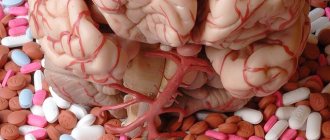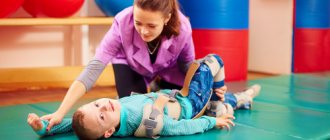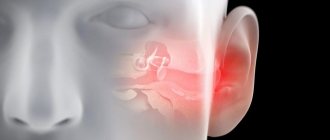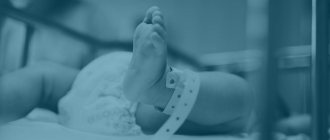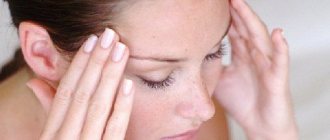What can cause an attack?
Infections that cause fever. The infection can be caused by bacteria, but more often febrile attacks occur with viral diseases (for example, roseola and influenza).
Vaccinations that cause fever. There is a small chance of febrile seizures after vaccination against measles, rubella and mumps, and diphtheria, tetanus and whooping cough. But the risks from incomplete vaccination are higher than the risk from a febrile attack after vaccination.
Heredity. If either parent has had a febrile seizure, the child is more likely to have seizures with fever.
A febrile attack, especially one occurring for the first time in life, is very frightening for parents. In fact, most of these attacks are not dangerous and do not lead to complications or brain damage. A child with simple febrile seizures is only slightly more likely to develop epilepsy than children who have never had a febrile seizure.
How to help a child during an attack?
- Place your baby on his side on a flat surface and make sure he won't fall or hit anything during the cramp (such as crib bars).
- Record the time and tell the doctor when the attack began and how long it lasted.
Attention! Do not try to open the jaw, do not put anything into the child’s mouth during an attack, this can lead to injuries (broken teeth of the child and injured fingers of the person providing assistance). Do not try to restrict the child's movements during seizures, do not restrain him.
The child may be even more afraid of the attack than the parents. Try to calm him down and support him.
If the attack occurs for the first time in life, lasts longer than 5 minutes, the child is unusually sleepy and lethargic before or after the attack, call an ambulance.
In other cases, immediately show the child to the pediatrician. The doctor should examine the child after the attack to make sure there are no signs of a central nervous system infection (meningitis or encephalitis).
What to do if your child has chills?
If your child is shivering, wrap him up first12, then use a thermometer to find out if he has a fever—this often accompanies muscle tremors8. If the thermometer shows high values, most likely the cause of the chills is fever8. In this case, it is impossible to warm up under warm clothes or a blanket - you need to allow the body to lose heat through the skin10. Also, do not rush to bring down the temperature, because this is a protective reaction of the body8. There are the following criteria by which you can determine that it is time to take antipyretic drugs8:
- temperature rise above 38 0C in children under 3 months;
- the thermometer value is above 39 0C in initially healthy children older than 3 months;
- temperature 37.5-38 0C and higher in children with seizures or diseases of the heart and central nervous system.
You should not blow or dry your child when he has a chill. These procedures can cause vasospasm and increase tremors8. The fact is that in order to blow it, you need to ventilate the room where the child is lying, while he should be uncovered, and not wrapped up. If you feel cold, it is also not recommended to open it8. Rubbing with warm water is allowed only in the absence of trembling8, no less than 30 minutes after taking antipyretics4. Do not wipe your child with vinegar or alcohol. Rubbing them into the skin may cause irritation8.
Severe and prolonged trembling, fever, pale and cold skin on the feet and palms may indicate severe illness and require emergency medical attention4.
If chills without fever are not associated with hypothermia and are not accompanied by a high temperature, and attempts to warm the child do not relieve shivering and cold sensations, there is a possibility that the symptoms are caused by hypoglycemia, thyroid deficiency, or nervous tension5,6,7. In this case, you need to contact a pediatrician, who will clarify the diagnosis and, if necessary, refer you to specialized specialists.
What medications can be given to a child for chills associated with a cold?
For the symptomatic treatment of fever and chills due to colds, not all medications are suitable for children. One of the approved and well-studied drugs is paracetamol8.
Paracetamol is included in combination preparations, for example, it is one of the active ingredients of RINZASIP® for children, a powder for preparing a hot drink9.
RINZASIP® for children reduces fever, sore throat, headache and muscle pain that can accompany colds. In addition to the antipyretic component, RINZASIP® for children contains pheniramine with an antiallergic effect and ascorbic acid, which increases the body's resistance9.
The drug is recommended for use from 6 years of age, the dose is determined by the doctor, depending on the age of the child and his condition. To prepare a hot drink, dissolve the contents of the sachet in a glass of warm water9.
Recommendations for taking RINZASIP ® for children9
| Age | Application according to instructions |
| 6-10 years | 1 sachet 2 times a day |
| 10-12 years | 1 sachet 3 times a day |
| 12-15 years | 1 sachet no more than 4 times a day |
The course of treatment should be no more than 5 days9. The interval between doses should be at least 4 hours9.
It is important to remember that although antipyretic therapy helps bring down the temperature and fight chills, it does not affect the cause of the disease and can “lubricate” its other manifestations, which often makes it difficult for the doctor to diagnose. Therefore, before giving children antipyretic drugs, be sure to consult a pediatrician to find the cause of the increase in body temperature8.
to come back to the beginning
How to treat fever in a child who has previously had febrile seizures?
If the child does not have an increase in temperature during illness or after vaccination, it is not recommended to give antipyretic drugs! This does not reduce the risk of an attack.
If the temperature has risen, medications to reduce it make you feel better overall, but do not help with attacks.
The harm from anticonvulsants for the prevention of febrile seizures outweighs the benefits; they are almost never prescribed.
If a child’s febrile convulsions are prolonged, at the beginning of the attack it is recommended to administer a drug from the benzodiazepine group in the form of an enema, a spray in the nose or a gel on the cheek. Unfortunately, none of these forms are registered in Russia. Therefore, if an attack lasts longer than 5 minutes, an emergency doctor may give an injection of such a medicine.
For antipyretic drugs, children can be given ibuprofen at a dose of 10 mg/kg every 8 hours or paracetamol at a dose of 15 mg/kg every 6 hours. Don't give children aspirin!
Childhood tics: symptoms, causes, treatment
Have you noticed that your child is blinking more often than usual, twitching his shoulders and coughing? Perhaps these are manifestations of tics. The chief pediatric neurologist of the Ministry of Health of the Tver Region, Galina Anatolyevna Zueva, will tell you why they occur and how to treat them correctly.
What are tiki?
Tics are involuntary violent movements that occur in certain muscle groups.
Tics most often occur in children aged 4 to 6 years . This is due to the maturation of the subcortical parts of the brain, which most often ends by the age of seven or eight years.
If for some reason the child’s body produces a little more activating (or, conversely, fewer inhibitory) neurons than required, and the regime of motor and other loads is not observed, then problems begin. This could be attention deficit hyperactivity disorder, or sleep disorders, or tics.
From three to four years old, your baby begins to grow very actively and explore the world. In order for the cognitive function to be rapid, for him to absorb a large amount of information, and for the brain to mature, the child needs a lot of activating neurotransmitters. He must have time to climb everywhere, jump, look, speak, talk, ask a bunch of questions, understand and assimilate everything he hears. If activating neurotransmitters are used correctly, then the child develops harmoniously: he is nimble, but at the same time he can control himself, follow the rules, and show perseverance during kindergarten classes. It is completely normal that your child is active, inquisitive, and fast. When a baby does not use these neurotransmitters for movement, communication, and learning (for example, he sits at home all day and is not allowed to go outside), then various problems may arise: hyperactivity syndrome, sleep disturbances, and behavior problems.
So, for a child to develop properly, he must run a lot, climb, talk, explore the world around him, and experience various emotions. This forms spatial-imaginative thinking, motor skills, synchronicity of the two hemispheres, develops the brain and at the same time correctly wastes all the produced neurotransmitters of activity. At the age of 3-5 years, a child is nimble, he switches quickly, but at the same time copes with his tasks: if he needs to sit, he will sit normally, study, do something. This is the standard development of a child that should be.
Types of tics in children
Most often, children aged 3-6 years have motor and vocal tics.
Motor tics are tics associated with movement: blinking, blinking, closing your eyes, twitching your nose, tugging at clothes, moving your shoulders, etc.
Vocal - tics associated with breathing. These are all kinds of hemming, sniffing, coughing, whistling. By the way, a common case in my practice: a child coughs for a long time, he is taken to doctors, they look for the cause, but in fact he has a vocal tic, which needs to be treated by a neurologist. This will not necessarily turn out to be a tick, but this also happens, and this must be taken into account.
Combinations of several tics occur quite often. For example, blinking, twitching the corners of the nose and behaving with the shoulders at the same time. Tics can also be more pronounced when certain muscle groups are involved at the time of the tic disorder, so-called segmental tics . There may be a combination of motor and vocal tics, such as eye blinking and grunting at the same time. At the same time, he can independently delay the manifestation of the tic for some time (up to several seconds) and repeat it upon request. This is the so-called duplication, which is a distinctive feature of tics from other types of obsessive movements - hyperkinesis.
A separate, most complex case of generalized tics is Tourette syndrome , when tic manifestations occur in multiple muscle groups, when the same child has several types of vocal tics. They are very pronounced and cause great inconvenience to the child. In this case, examination and treatment by a neurologist is strictly required.
Tics can be transient, i.e. appeared, were observed in the child for some time, and then went away. But if the tics continue for more than a year, then these are already chronic tics , so examination and treatment are required.
Causes of tics in children
As we have already said, this is a lesion of the subcortical formations in the child’s brain. It may be due to the development of the brain or be damaged by some factor.
A sedentary lifestyle is one of the most common triggers for tics. When a child is not active enough, he does not use up all the activity neurotransmitters. Muscles need to move, but they don't get it. As a result, tics occur. The child must run, and it is better not along a flat asphalt path, but along a forest path, where you need to crawl under a tree somewhere, run along a log, and turn away from the root. All this better shapes the nervous system and helps develop spatial-imaginative thinking. No chance to go to the forest? In the park, leave the level path and walk along the dirt path, just dress appropriately so that both you and your baby feel comfortable. This is one of the common mistakes of parents: they spend hours walking in parks, walking smartly along the paths, but this is of little benefit. It is much more useful for a child to be closer to nature, to study, to learn. And the many emotions that he receives at the same time correctly expend the energy inherent in him. When a child sits at home all day with a tablet, this energy accumulates, and then results in fights, disobedience, and tics, among other things.
Children with attention deficit disorder are especially susceptible to tics . Because of their illness, they already have a disruption in the formation of neurotransmitters, and when we do not allow them to fully expend all this energy, various problems appear: headaches, insomnia, tics.
An unfavorable psycho-emotional environment is another common cause of tics in children. For example, if a child really does not like going to kindergarten, which causes negative emotions in him and creates a lot of stress, and the parents do not have time to discuss this situation with him, explain it, and come to an agreement. In this case, the child’s nervousness can also have a side effect in the form of a tic.
Some difficult situation in the family , for example, when parents demand high results from the child in all subjects, forming the so-called excellent student syndrome. The child is afraid of not being able to cope, he has a great responsibility, and as a result, neuroses and tics arise, most often vocal ones. Moreover, they can persist for a long time, manifesting themselves in stressful situations.
A common cause of tics is a divergence of views on raising a child in the same family . When, for example, parents treat him strictly, and grandparents, on the contrary, indulge all his whims. The child ceases to understand how to behave, and this leads to neurosis.
All this applies to common tics in children aged 4 to 6 years. But there are also more difficult cases. If tics appear in children over seven years of age , then the reason is no longer due to the normal maturation of the body, but to some kind of pathology.
This may be a consequence of having suffered from frequent sore throats, streptococcus , when an autoimmune process occurs that damages the subcortical formations and malfunctions in the form of various tics or hyperkinesis. They definitely need to be treated.
The cause may also be the consequences of frequent mononucleosis ; this virus also often affects the subcortical nuclei.
There are a number of hereditary diseases that cause tics. They are rare, but still. For example, diseases associated with impaired proper breakdown of copper and iron. Among them is Wilson-Konovalov disease, in which copper begins to be deposited in the liver and other internal organs, including in the subcortical formations of the brain and leads to various types of hyperkinesis and tics. These diseases must be excluded in children with tics.
When is it necessary to treat tics in children?
If these are single simple motor tics in a child aged 4 to 6 years, they are rare and do not interfere with the child’s life, then most likely this is due to a slight excess of neurotransmitters. Such tics do not need to be treated ; they will go away on their own in a year or two.
However, if tics are frequent and prevent the child from concentrating, then, of course, this needs to be examined and treated .
Pay special attention to tics that appear in a child after 7-8 years . They definitely need to be examined and the cause of their occurrence must be found out.
I must say that tics can be treated well . Now there are quite a lot of high-quality drugs. It is important here that the doctor correctly selects the right medicine and dosage. To treat tics, a special dosage regimen is used; the dosage here is slightly higher than usual, but you should not worry about this - the drugs are well tolerated and will not harm the child’s health. Sometimes for chronic tics, medications are given for the entire school year.
Prevention of tics in children
Follow these simple recommendations, and your child will grow up healthy and happy.
Walk with your child as much as possible. It’s good if he runs not only around the yard or a flat path, but also along earthen paths with some small obstacles. To do this, just leave the main alley in the park and go explore the lawns.
Study natural phenomena. Listen to the sounds of nature, teach your child to distinguish between them, and learn with him the laws of the world around him. All this will not only develop the baby’s brain, but will also help him use neurotransmitters usefully and cope with stress.
Play active games with your child. It is considered normal when a child aged 2 to 5 years spends about 10 hours a day in active movement. Let's say he worked out, drew, then ran in the yard, played with the dog, went down the slide, explored something, met someone on the playground, talked, then rested and ran back to play. Then the neurotransmitters will be used correctly and the child will not have problems with sleep, nervousness, or behavior.
Talk to your child. And this is a very important point. Something that many parents often forget. In the meantime, it is conversations with the baby that can solve many neurological problems. It is important not just to talk to your child, but also to listen to what he says back to you. From the age of two, the child has every right to make some decisions, to choose something - for example, what T-shirt to wear for a walk or what color to take a toy. Give him the opportunity to participate in the life of the family, listen to his opinion. You need to understand that this opinion must be reasoned, that is, not just “I want”, but “I want because...” This will not only help you create and maintain a trusting relationship with your child, but will also keep him healthy and save him from a variety of behavioral problems.
Good luck to you and your children!
It is important to know
Parents often mistake normal chills associated with fever for febrile seizures. With such chills, the child's arms and legs may shake rhythmically. This is similar to a seizure, but the child is conscious and reacts if spoken to. So that the doctor can better determine whether what happened was a seizure, and if so, what kind, try to clearly record the duration of the seizure, describe it as specifically as possible, and ideally, record what is happening on video (one person helps the child, the other films it on the phone).
Causes of chills in children
Cold sensations and muscle tremors often indicate the onset of an infection or fever,1 but they can occur without a high fever.
Chills in a child with fever are often a manifestation of an infectious disease. In this case, fever becomes a protective reaction that activates the immune system and helps fight infectious agents3. Chills associated with the “invasion” of viruses and bacteria can also be accompanied by various manifestations of colds, diarrhea and urinary tract infections. May be observed:
- manifestations of intoxication - headache and muscle pain, poor health13;
- symptoms of respiratory tract damage - sore throat, runny nose, cough, shortness of breath10;
- disorders of the digestive system - vomiting, diarrhea10;
- dysuria - frequent and painful urination, difficult urge to urinate11.
Sometimes chills are not associated with infection or inflammation, so it is important for parents to pay attention to other accompanying symptoms and tell their doctor about them.
There are also many reasons why children develop chills without fever. Here are some of them:
- Hypothermia . At low ambient temperatures, the body tries to prevent the internal organs from cooling. In response to cold, two reactions occur: the body reduces heat loss through the skin - a spasm of the superficial vessels of the skin occurs - and increases heat production, stimulating muscle contraction. In addition to the muscles of the trunk, the chewing muscles are also involved in the work - that is why, when a child is cold, he begins to “chatter his teeth.” As soon as the body warms up, muscle tremors stop2.
- Hypothyroidism is insufficiency of the thyroid gland. With this disease, heat production decreases, which is manifested by a feeling of coldness and chilliness. In children, hypothyroidism can be congenital or occur due to a lack of iodine in the body. Additional symptoms typically include swelling, dry skin, muscle weakness, constipation and hearing loss5.
- Hypoglycemia is a low level of glucose in the blood that occurs during fasting, intense muscular work, or diabetes (if you take the wrong dose of insulin or eat incorrectly). Chills may be accompanied by sweating, confusion, and other symptoms6.
- Vegetative crisis. It is more common in schoolchildren and adolescents and is associated with dysregulation of the nervous system or, more simply, “neurosis.” Additional signs are usually feelings of anxiety, fear, nervous tension, increased blood pressure, and headache7.
to come back to the beginning

